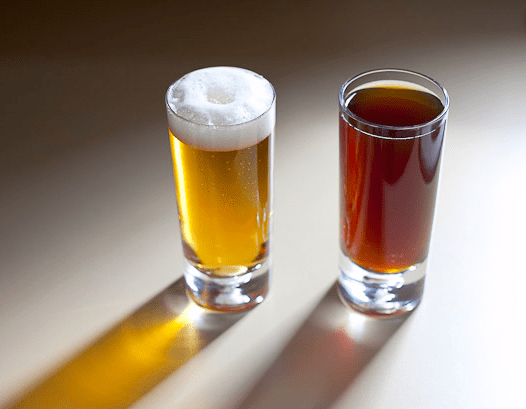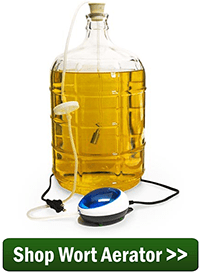 One of several problems that can happen in beer brewing is oxidation. Blogger Bryan Roth explores oxidation, its effects, what causes it, and how to avoid it.
One of several problems that can happen in beer brewing is oxidation. Blogger Bryan Roth explores oxidation, its effects, what causes it, and how to avoid it.
———-
The process of oxidation is detrimental to your beer, but it’s something that can be difficult to avoid. To some degree, oxidation in homebrew will occur whether you keg or bottle your beer.
Oxidation in homebrew is a chemical process that can destabilize it and cause stale, off-flavors. Most commonly, people describe the taste of oxidized beers as having flavors of wet cardboard, sherry, or fruit, but that’s not the only issue. Along with altering the taste of your beer, oxidation can also affect the quality of your beer. Having oxidation in your homebrew can cause it to be less stable, meaning it will not stay as fresh as long.
When Oxygen Is Good For Homebrew?
A tricky part of the oxidation concept is that oxygen is actually beneficial early in the brewing process, so there is a time when oxidation in the homebrew is good. Properly aerating your wort on brew day can be pivotal to a successful homebrew, as oxygen is critical for yeast health.
 After you’ve boiled and cooled your wort and moved it into your primary fermenter, take a few minutes to rapidly stir or shake and rock your wort. At this early stage, building a frothy head on your wort is good, as pitched yeast will need the air for healthy growth and will remove the oxygen during the fermentation process. You can even purchase aeration devices to help this process.
After you’ve boiled and cooled your wort and moved it into your primary fermenter, take a few minutes to rapidly stir or shake and rock your wort. At this early stage, building a frothy head on your wort is good, as pitched yeast will need the air for healthy growth and will remove the oxygen during the fermentation process. You can even purchase aeration devices to help this process.
After you’ve pitched your yeast and fermentation has begun, you’ll want to avoid shaking and agitating your beer as much as possible.
When Oxidation May Occur In Your Homebrew
Oxidation can take place at many points throughout the brewing process, from creating a large froth while stirring your mash to the moment you move your beer into a keg or bottle. For most homebrewers, their beer is at greatest risk of oxidation while racking from one carboy to another or into their final vessel of choice, whether it be bottle or keg.
In all these instances, it’s important to try and avoid splashing of your beer. You’ll be able to tell when you’re at risk whenever you see a growing froth on top of your wort or beer. If you’re racking, pay attention to your tubing: if you see a lot of bubbles moving through, check the fitting of your tubing  and siphon connections to make sure they’re tight. While moving beer from one carboy to another, allow your siphon tubing to rest on the bottom of the secondary fermenter or as close to the rising beer as possible. This will dramatically reduce the oxidation in your homebrew.
and siphon connections to make sure they’re tight. While moving beer from one carboy to another, allow your siphon tubing to rest on the bottom of the secondary fermenter or as close to the rising beer as possible. This will dramatically reduce the oxidation in your homebrew.
How to Avoid Oxidation In Homebrew When Kegging or Bottling
Homebrewers who keg their beer may have an easier time avoiding the effects of oxidation so long as they’ve been careful in other steps of the brewing process. Purging a keg with CO2 before and after filling it with homebrew will help keep the beer fresh.
Those who bottle, however, will still want to make sure to avoid unnecessary splashing or air bubbles while racking into bottles. Moving a homebrew from a carboy to a bottling bucket can help, as a spigot and properly fitted tubing will move the beer safely from one vessel to your bottle. Luckily, the yeast that will carbonate your beer will consume some of the oxygen that may make it into the bottles.
 Many homebrewers also prefer to use oxygen absorbing bottle caps that will help mitigate oxidation. Be sure to also store your beer in a place where temperatures are controlled and preferably cool. Warm storage can promote oxidation in homebrew.
Many homebrewers also prefer to use oxygen absorbing bottle caps that will help mitigate oxidation. Be sure to also store your beer in a place where temperatures are controlled and preferably cool. Warm storage can promote oxidation in homebrew.
Bottled beers can’t help but become oxidized over time, so know that some beers styles may be impacted greater than others. Your IPA, for example, may have a shift in its hop flavor compared to a barleywine or imperial stout, which may actually find pleasant tastes from sitting in cool storage for a little longer than normal.
The important thing to remember when it comes to oxidation in homebrew is that once properly carbonated, many beer styles are meant to be consumed fresh. Don’t be afraid to pop your cap and enjoy it!
—–
Bryan Roth is a beer nerd and homebrewer living in Durham, North Carolina. You can read his thoughts on beer and the beer industry on his blog, This Is Why I’m Drunk, and send him suggestions on how to get his wife to drink craft beer via Twitter at @bryandroth.

No such thing as hot side aeration/oxidation! Next thing you people are going to suggest is don’t boil? My beer comes out fine and nobody turns down a second… because of quality sanitation, ingredients, and overall process! Chasing with C02 is a procedure that will help but that’s about it other than common sense.
Couldn’t agree more Mike. I’ve splashed my beer about with gay abandon for decades and not once have I ever experienced any HSA/oxidation. I believe wet cardboard taste (etc) can all be avoided by good sterilising techniques. And my teddy bear agrees with me.
my airlock keeps blowing off my glass 5gal carboy, Is it safe to leave this off?
Common sense isn’t a thing in homebrew chemistry. While hot side aeration does exist, it is very rare at the homebrew scale.
Cold side oxidation exists though which is what this article is also about. Especially with modern IPAs hopped at 10g per litre or more.
You may add 1 tsp of ascorbic acid (per 5 gallons) to the secondary carboy when transferring from primary to secondary to help avoid oxidization. This can also be used to keg or bottle.
Does this really work? And it can’t hurt, right?
Ascorbic acid (better known as Vitamin C) is a “potent” antioxidant that is used in many oxygen sensitive foods. Oxygen will preferentially react with it, rather than the chemicals in your beer (esters and polyphenols, which if it does, will reduce fruity and floral esters and increase browning). So we put it in foods so that if a little oxygen gets in, it’ll react with the ascorbic and not your beer. Think cut apples at the store. If you don’t treat with ascorbic, you get oxygen reacting and browning the apple. Since it naturally occurs in citrus and other foods, it’s regarded as a safe food additive, 1 tsp in 5 gallons will not add any flavor to your beer, but will “eat up” any minor oxygen before you layer some CO2 on the surface.
Or just don’t use a secondary carboy.